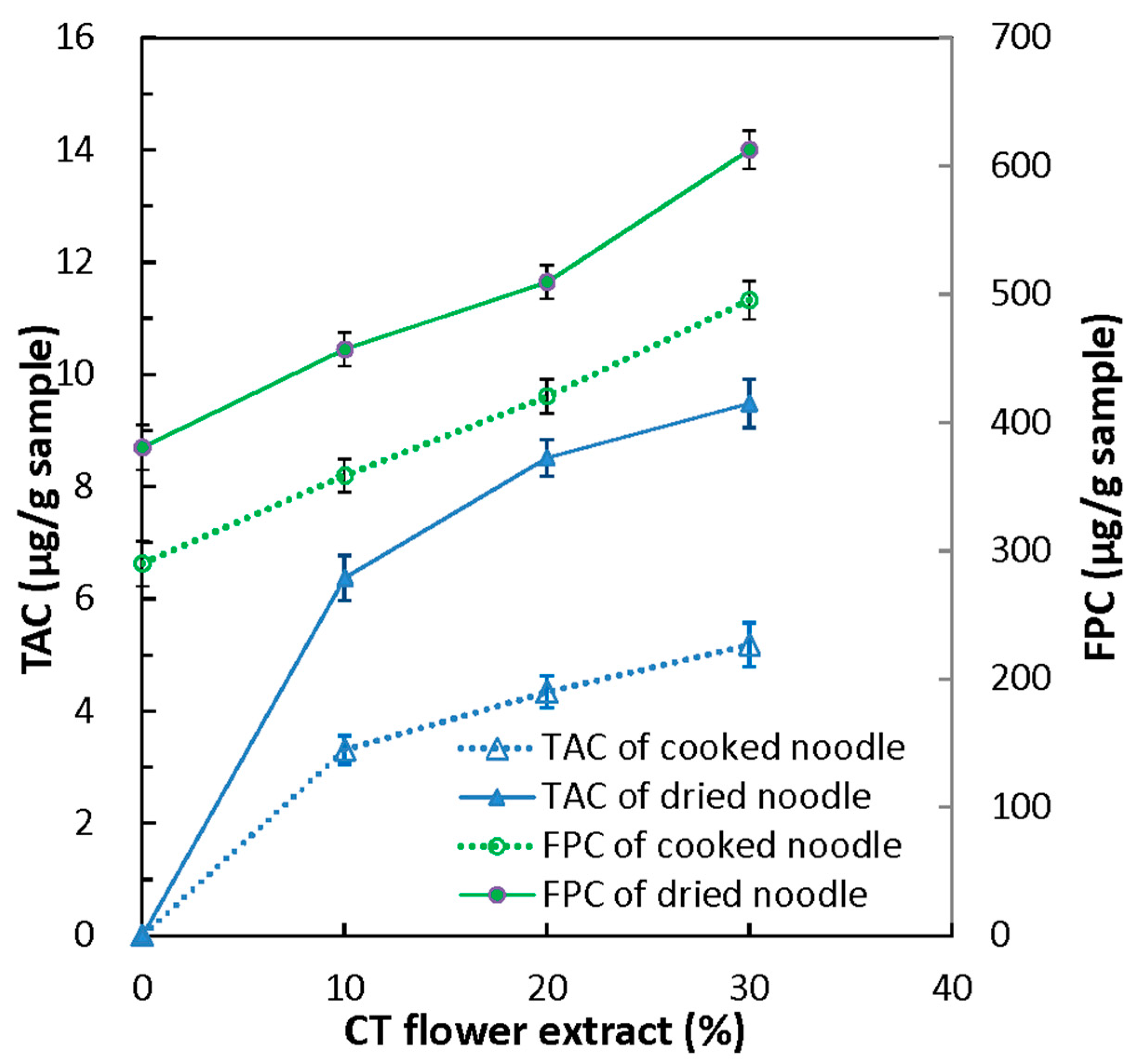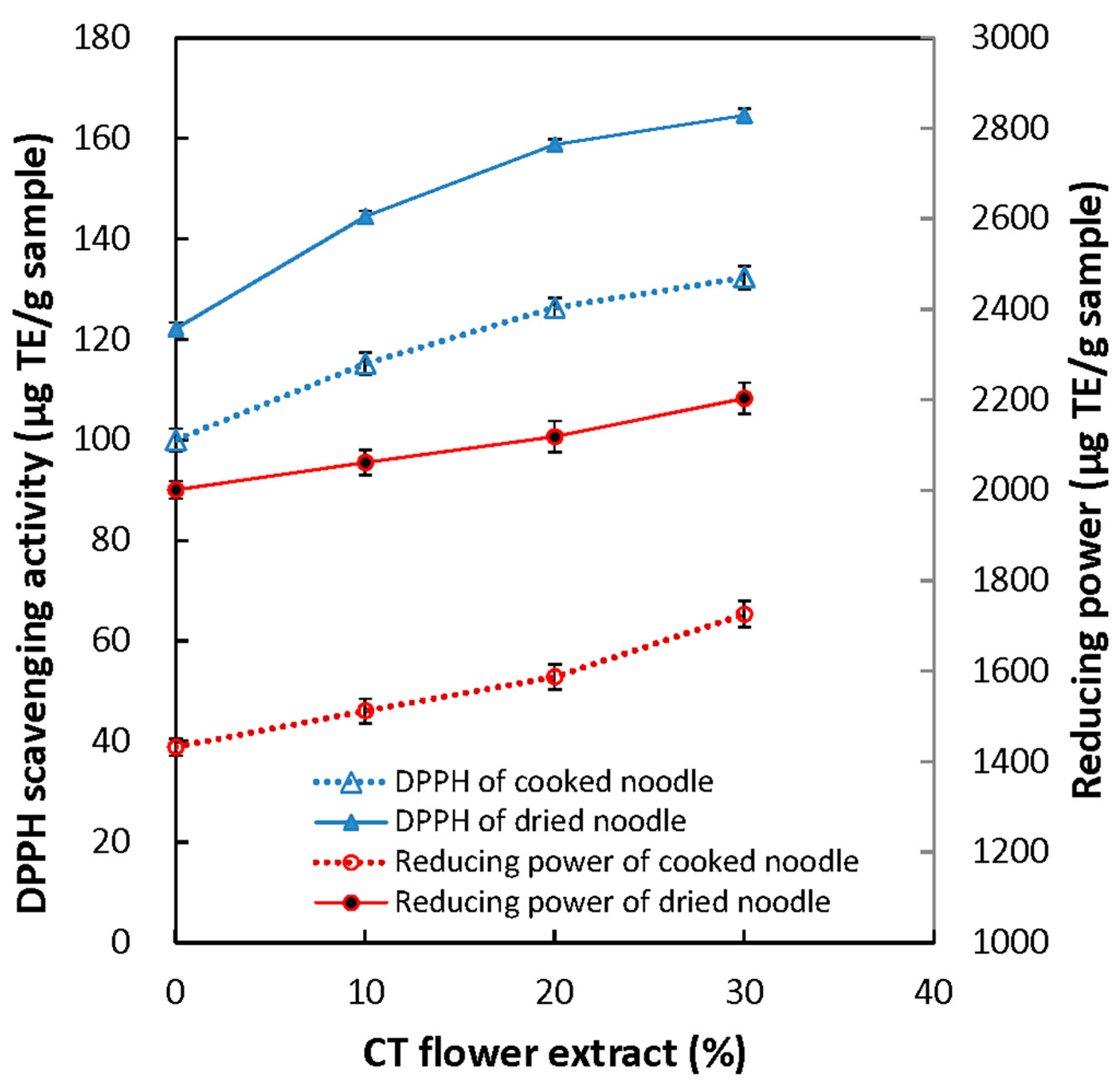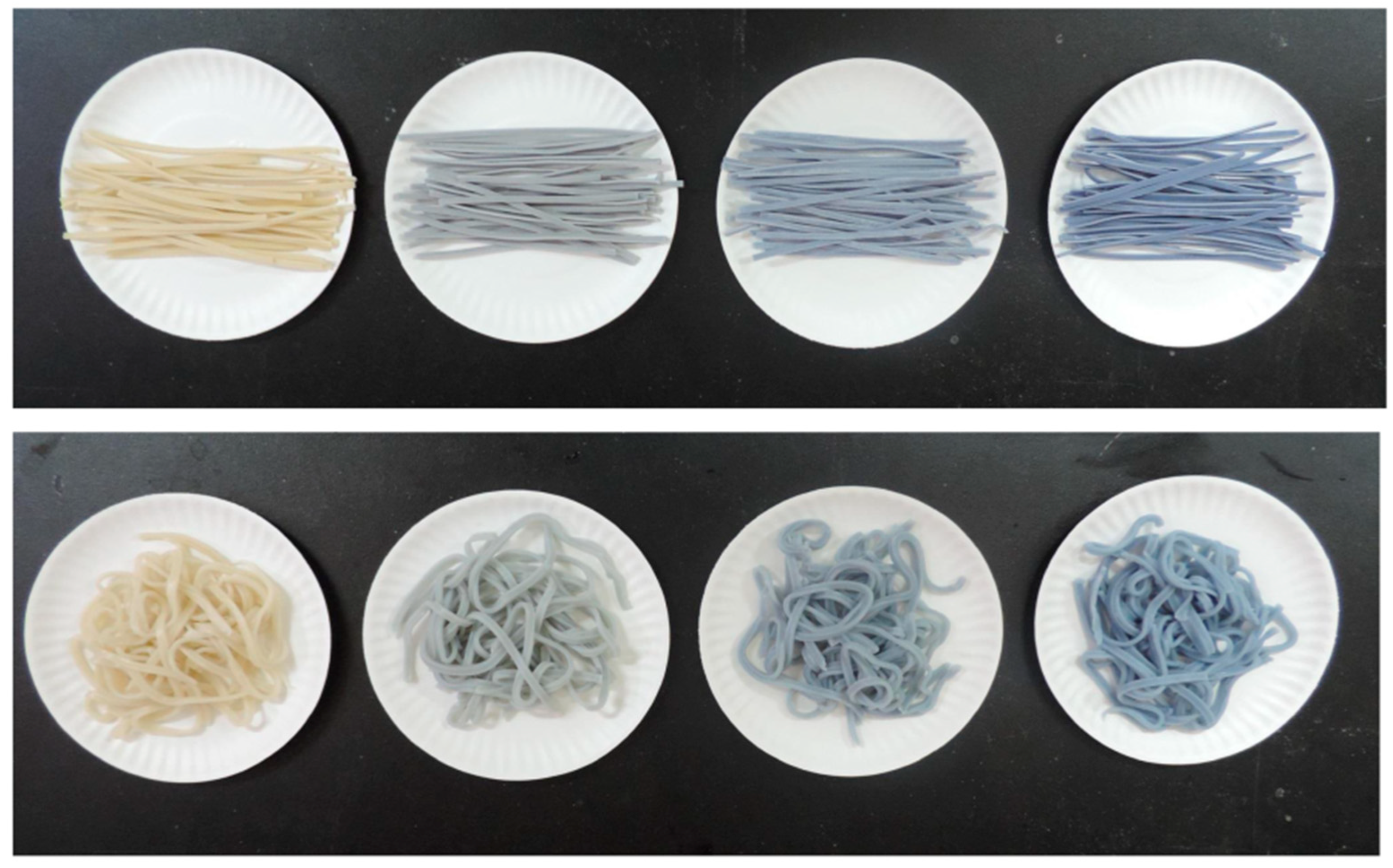Phytochemical-Rich Colored Noodles Fortified with an Aqueous Extract of Clitoria ternatea Flowers
Abstract
1. Introduction
2. Materials and Methods
2.1. Materials
2.2. Preparation of CTFE
2.3. Noodle Preparation
2.4. Total Anthocyanin Content (TAC)
2.5. Free Polyphenolic Content (FPC)
2.6. Antioxidant Activity
2.7. Color of Noodle
2.8. Breaking and Cutting Forces of Noodle
2.9. Tensile Strength and Extensibility of Noodle
2.10. Stress Relaxation of Noodle
2.11. Cooking Quality of Noodle
2.12. Sensory Evaluation
2.13. Statistical Analysis
3. Results and Discussion
3.1. Total Anthocyanins of Noodle
3.2. FPC and Antioxidant Capacity of Noodle
3.3. Color of Noodle
3.4. Textural, Rheological and Cooking Properties of Noodle
3.5. Sensory Evaluation of Noodle
4. Conclusions
Author Contributions
Funding
Institutional Review Board Statement
Informed Consent Statement
Data Availability Statement
Acknowledgments
Conflicts of Interest
References
- Cai, M.; Shen, C.; Li, Y.; Xiong, S.; Li, F. The Quality Characteristics Comparison of Stone-Milled Dried Whole Wheat Noodles, Dried Wheat Noodles, and Commercially Dried Whole Wheat Noodles. Foods 2022, 12, 55. [Google Scholar] [CrossRef] [PubMed]
- Ma, M.; Xie, Y.; Wang, C. Effect of anthocyanin-rich extract from black soybean coat on wheat dough rheology and noodle texture. J. Food Process. Preserv. 2020, 45, 15007. [Google Scholar] [CrossRef]
- Boff, J.M.; Strasburg, V.J.; Ferrari, G.T.; Schmidt, H.D.O.; Manfroi, V.; de Oliveira, V.R. Chemical, Technological, and Sensory Quality of Pasta and Bakery Products Made with the Addition of Grape Pomace Flour. Foods 2022, 11, 3812. [Google Scholar] [CrossRef] [PubMed]
- Sethi, S.; Nanda, S.K.; Bala, M. Quality assessment of pasta enriched with anthocyanin-rich black rice bran. J. Food Process. Preserv. 2020, 44, 14952. [Google Scholar] [CrossRef]
- Shiau, S.; Li, G.; Pan, W.; Xiong, C. Effect of pitaya peel powder addition on the phytochemical and textural properties and sensory acceptability of dried and cooked noodles. J. Food Process. Preserv. 2020, 44, 14491. [Google Scholar] [CrossRef]
- Gamage, G.C.V.; Lim, Y.Y.; Choo, W.S. Anthocyanins from Clitoria ternatea Flower: Biosynthesis, Extraction, Stability, Antioxidant Activity, and Applications. Front. Plant Sci. 2021, 12, 792303. [Google Scholar] [CrossRef]
- Escher, G.B.; Wen, M.; Zhang, L.; Rosso, N.D.; Granato, D. Phenolic composition by UHPLC-Q-TOF-MS/MS and stability of anthocyanins from Clitoria ternatea L. (butterfly pea) blue petals. Food Chem. 2020, 331, 127341. [Google Scholar] [CrossRef]
- Li, C.; Tang, W.; Chen, S.; He, J.; Li, X.; Zhu, X.; Li, H.; Peng, Y. Phytochemical Properties and In Vitro Biological Activities of Phenolic Compounds from Flower of Clitoria ternatea L. Molecules 2022, 27, 6336. [Google Scholar] [CrossRef]
- Nair, V.; Bang, W.Y.; Schreckinger, E.; Andarwulan, N.; Cisneros-Zevallos, L. Protective Role of Ternatin Anthocyanins and Quercetin Glycosides from Butterfly Pea (Clitoria ternatea Leguminosae) Blue Flower Petals against Lipopolysaccharide (LPS)-Induced Inflammation in Macrophage Cells. J. Agric. Food Chem. 2015, 63, 6355–6365. [Google Scholar] [CrossRef]
- Jokioja, J.; Yang, B.; Linderborg, K.M. Acylated anthocyanins: A review on their bioavailability and effects on postprandial carbohydrate metabolism and inflammation. Compr. Rev. Food Sci. Food Saf. 2021, 20, 5570–5615. [Google Scholar] [CrossRef]
- Vuong, T.T.; Hongsprabhas, P. Influences of pH on binding mechanisms of anthocyanins from butterfly pea flower (Clitoria ternatea) with whey powder and whey protein isolate. Cogent Food Agric. 2021, 7, 1889098. [Google Scholar] [CrossRef]
- Terahara, N.; Toki, K.; Saito, N.; Honda, T.; Matsui, T.; Osajima, Y. Eight new anthocyanins, ternatins C1-C5 and D3 and preternatins A3 and C4 from young Clitoria ternatea flowers. J. Nat. Prod. 1998, 61, 1361–1367. [Google Scholar] [CrossRef]
- Thuy, N.M.; Minh, V.Q.; Ben, T.C.; Nguyen, M.T.T.; Ha, H.T.N.; Tai, N.V. Identification of anthocyanin compounds in butterfly pea flowers (Clitoria ternatea L.) by ultra performance liquid chromatography/ultraviolet coupled to mass spectrometry. Molecules 2021, 26, 4539. [Google Scholar] [CrossRef] [PubMed]
- Sohany, M.; Tawakkal, I.S.M.A.; Ariffin, S.H.; Shah, N.N.A.K.; Yusof, Y.A. Characterization of Anthocyanin Associated Purple Sweet Potato Starch and Peel-Based pH Indicator Films. Foods 2021, 10, 2005. [Google Scholar] [CrossRef]
- Blesso, C.N. Dietary Anthocyanins and Human Health. Nutrients 2019, 11, 2107. [Google Scholar] [CrossRef]
- Eliášová, M.; Kotíková, Z.; Lachman, J.; Orsák, M.; Martinek, P. Influence of baking on anthocyanin content in coloured-grain wheat bread. Plant Soil Environ. 2020, 66, 381–386. [Google Scholar] [CrossRef]
- Guo, Y.; Zhang, H.; Shao, S.; Sun, S.; Yang, D.; Lv, S. Anthocyanin: A review of plant sources, extraction, stability, content determination and modifications. Int. J. Food Sci. Technol. 2022, 57, 7573–7591. [Google Scholar] [CrossRef]
- Voss, D.M.; Miyagusuku-Cruzado, G.; Giusti, M.M. Thermal stability comparison between 10-catechyl-pyranoanthocyanins and anthocyanins derived from pelargonidin, cyanidin, and malvidin. Food Chem. 2023, 403, 134305. [Google Scholar] [CrossRef]
- Fu, X.Y.; Wu, Q.; Wang, J.; Chen, Y.L.; Zhu, G.P.; Zhu, Z.X. Spectral characteristic, storage stability and antioxidant properties of anthocyanin extracts from flowers of butterfly pea (Clitoria ternatea L.). Molecules 2021, 26, 7000. [Google Scholar] [CrossRef]
- Verma, J.; Rani, V.; Sangwan, V.; Karnika, K. Physical, sensory and nutritional quality of anthocyanins rich pasta prepared using biofortified purple wheat. Ann. Phytomedicine Int. J. 2022, 11, 78–85. [Google Scholar] [CrossRef]
- Zanoletti, M.; Parizad, P.A.; Lavelli, V.; Cecchini, C.; Menesatti, P.; Marti, A.; Pagani, M.A. Debranning of purple wheat: Recovery of anthocyanin-rich fractions and their use in pasta production. LWT 2017, 75, 663–669. [Google Scholar] [CrossRef]
- Lee, J.; Durst, R.W.; Wrolstad, R.E.; Wrolstad, R.E. Determination of Total Monomeric Anthocyanin Pigment Content of Fruit Juices, Beverages, Natural Colorants, and Wines by the pH Differential Method: Collaborative Study. J. AOAC Int. 2005, 88, 1269–1278. [Google Scholar] [CrossRef]
- Shiau, S.; Yu, Y.; Pan, W.; Li, G. Colorful and health improving Chinese steamed bread fortified by anthocyanin-rich extract of butterfly pea flower. J. Food Process. Preserv. 2022, 46, 16925. [Google Scholar] [CrossRef]
- Buçukoglu, T.Z.; Albayrak, S.; Halici, M.G.; Tay, T. Antimicrobial and Antioxidant Activities of Extracts and Lichen Acids Obtained from Some Umbilicaria Species from Central Anatolia, Turkey. J. Food Process. Preserv. 2013, 37, 1103–1110. [Google Scholar] [CrossRef]
- Liyana-Pathlrana, C.M.; Shahidi, F. Antioxidant and free radical scavenging activities of whole wheat and milling fractions. Food Chem. 2007, 101, 1151–1157. [Google Scholar] [CrossRef]
- Oyaizu, M. Studies on products of browning reaction. Antioxidative activities of products of browning reaction prepared from glucosamine. Jpn. J. Nutr. Diet. 1986, 44, 307–315. [Google Scholar] [CrossRef]
- Pan, W.C.; Liu, Y.M.; Shiau, S.Y. Effect of okara and vital gluten on physico-chemical properties of noodle. Czech J. Food Sci. 2018, 36, 301–306. [Google Scholar] [CrossRef]
- Bellido, G.; Hatcher, D. Asian noodles: Revisiting Peleg’s analysis for presenting stress relaxation data in soft solid foods. J. Food Eng. 2009, 92, 29–36. [Google Scholar] [CrossRef]
- Peleg, M.; Normand, M.D. Comparison of two methods for stress relaxation data presentation of solid foods. Rheol. Acta 1983, 22, 108–113. [Google Scholar] [CrossRef]
- Salacheep, S.; Kasemsiri, P.; Pongsa, U.; Okhawilai, M.; Chindaprasirt, P.; Hiziroglu, S. Optimization of ultrasound-assisted extraction of anthocyanins and bioactive compounds from butterfly pea petals using Taguchi method and Grey relational analysis. J. Food Sci. Technol. 2020, 57, 3720–3730. [Google Scholar] [CrossRef] [PubMed]
- Patras, A.; Brunton, N.P.; O’Donnell, C.; Tiwari, B. Effect of thermal processing on anthocyanin stability in foods; mechanisms and kinetics of degradation. Trends Food Sci. Technol. 2010, 21, 3–11. [Google Scholar] [CrossRef]
- Thanh, V.T.; Tran, N.Y.T.; Linh, N.T.V.; Vy, T.A.; Truc, T.T. Application of anthocyanin natural colors from Butterfly Pea (Clitoria ternatea L.) extracts to cupcake. IOP Conf. Ser. Mater. Sci. Eng. 2020, 736, 062014. [Google Scholar] [CrossRef]
- Singh, R.; Yu, C.-C.; Chen, G.-W.; Chen, C.-H.; Sinaki, N.Y.; Lin, J.; Koksel, F. Butterfly Pea Flower as a Novel Ingredient to Produce Antioxidant-Enriched Yellow Pea-Based Breakfast Cereals. Foods 2022, 11, 3447. [Google Scholar] [CrossRef] [PubMed]
- Chusak, C.; Henry, C.J.; Chantarasinlapin, P.; Techasukthavorn, V.; Adisakwattana, S. Influence of Clitoria ternatea Flower Extract on the In Vitro Enzymatic Digestibility of Starch and Its Application in Bread. Foods 2018, 7, 102. [Google Scholar] [CrossRef] [PubMed]
- Porntip, P.; Theerapat, P.; Nontapat, S.; Chonlada, C.; Piyawan, W.; Sirichai, A.; Sathaporn, N. Physicochemical, antioxidant and sensory characteristics of sponge cakes fortified with Clitoria ternatea extract. J. Food Sci. Technol. 2018, 55, 2881–2889. [Google Scholar]
- Marpaung, A.M.; Andarwulan, N.; Hariyadi, P.; Faridah, D.N. The Difference in Colour Shifting of Clitoria ternatea L. Flower Extract at pH 1, 4, and 7 During Storage. Curr. Nutr. Food Sci. 2019, 15, 694–699. [Google Scholar] [CrossRef]
- Simić, M.; Žilić, S.; Šimuruna, O.; Filipčev, B.; Škrobot, D.; Vančetović, J. Effects of Anthocyanin-Rich Popping Maize Flour on the Phenolic Profile and the Antioxidant Capacity of Mix-Bread and Its Physical and Sensory Properties. Pol. J. Food Nutr. Sci. 2018, 68, 299–308. [Google Scholar] [CrossRef]
- Rashid, N.F.M.; Zulkifli, N.A.; Anwar, N.Z.R.; Gani, H.S.M.; Jusoh, T. Physicochemical properties, antioxidant activities and sensory evaluation of butterfly pea (Clitoria ternatea L.) ice cream flavoured with citrus juice. Biosci. Rep. 2022, 19, 73–81. [Google Scholar]
- Li, J.; Wang, B.; He, Y.; Wen, L.; Nan, H.; Zheng, F.; Liu, H.; Lu, S.; Wu, M.; Zhang, H. A review of the interaction between anthocyanins and proteins. Food Sci. Technol. Int. 2021, 27, 470–482. [Google Scholar] [CrossRef]
- Rakhesh, N.; Fellows, C.; Sissons, M. Evaluation of the technological and sensory properties of durum wheat spaghetti enriched with different dietary fibres. J. Sci. Food Agric. 2015, 95, 2–11. [Google Scholar] [CrossRef]
- Santiago, D.M.; Kawashima, Y.; Matsushita, K.; Noda, T.; Pelpolage, S.; Tsuboi, K.; Kawakami, S.; Koaze, H.; Yamauchi, H. Noodle Qualities of Fresh Pasta Supplemented with Various Amounts of Purple Sweet Potato Powder. Food Sci. Technol. Res. 2016, 22, 307–316. [Google Scholar] [CrossRef]



| CTFE (%) | Kind | L* | a* | b* | WI |
|---|---|---|---|---|---|
| 0 | Dried noodle | 70.72 ± 0.74 b | 1.24 ± 0.22 a | 17.69 ± 0.56 a | 65.77 ± 0.90 b |
| 10 | Dried noodle | 58.40 ± 0.40 e | −3.35 ± 0.18 c | −1.30 ± 0.25 d | 58.25 ± 0.42 e |
| 20 | Dried noodle | 54.97 ± 0.95 g | −3.81 ± 0.23 d | −7.11 ± 0.22 f | 54.25 ± 0.96 g |
| 30 | Dried noodle | 46.73 ± 0.59 h | −3.95 ± 0.18 d | −11.00 ± 0.19 h | 45.46 ± 0.59 h |
| 0 | Cooked noodle | 73.70 ± 0.41 a | −1.54 ± 0.14 b | 8.04 ± 0.25 b | 72.46 ± 0.36 a |
| 10 | Cooked noodle | 64.50 ± 0.67 c | −4.84 ± 0.27 e | −0.41 ± 0.18 c | 64.17 ± 0.67 c |
| 20 | Cooked noodle | 60.38 ± 0.60 d | −5.95 ± 0.19 f | −6.42 ± 0.17 e | 59.42 ± 0.60 d |
| 30 | Cooked noodle | 56.85 ± 0.31 f | −6.67 ± 0.13 g | −9.20 ± 0.12 g | 55.38 ± 0.32 f |
| CTFE (%) | Breaking Force (mN) | Cutting Force (mN) | Tensile Strength (mN) | Extensibility (mm) | Moisture Content (%) | Cooking Loss (%) |
|---|---|---|---|---|---|---|
| 0 | 1779 ± 85 a | 1732 ± 67 a | 399.7 ± 24.5 a | 55.21 ± 3.07 a | 64.77 ± 0.47 a | 4.31 ± 0.13 a |
| 10 | 1760 ± 98 a | 1687 ± 66 ab | 393.3 ± 10.7 a | 52.49 ± 2.68 a | 64.39 ± 0.59 a | 4.43 ± 0.11 a |
| 20 | 1674 ± 82 a | 1595 ± 70 bc | 385.8 ± 16.6 a | 46.41 ± 3.02 b | 64.93 ± 0.51 a | 4.28 ± 0.12 a |
| 30 | 1712 ± 73 a | 1550 ± 57 c | 323.8 ± 10.1 b | 39.90 ± 2.67 c | 65.58 ± 0.54 a | 4.42 ± 0.15 a |
| Dried Noodle | Cooked Noodle | |||||
|---|---|---|---|---|---|---|
| CTFE (%) | Color | Flavor | Color | Flavor | Texture | Overall |
| 0 | 4.45 ± 1.26 b | 4.46 ± 1.04 a | 4.31 ± 1.13 b | 4.26 ± 1.09 a | 5.17 ± 1.03 a | 5.21 ± 1.02 a |
| 10 | 4.35 ± 1.17 b | 4.50 ± 1.38 a | 4.37 ± 1.26 b | 4.43 ± 0.95 a | 4.92 ± 1.29 a | 4.93 ± 1.16 a |
| 20 | 5.56 ± 1.35 a | 4.43 ± 0.87 a | 5.25 ± 1.30 a | 4.96 ± 1.12 a | 5.16 ± 1.45 a | 5.25 ± 1.23 a |
| 30 | 5.93 ± 0.92 a | 4.70 ± 0.92 a | 5.72 ± 1.05 a | 4.83 ± 1.36 a | 5.03 ± 1.67 a | 5.36 ± 1.15 a |
Disclaimer/Publisher’s Note: The statements, opinions and data contained in all publications are solely those of the individual author(s) and contributor(s) and not of MDPI and/or the editor(s). MDPI and/or the editor(s) disclaim responsibility for any injury to people or property resulting from any ideas, methods, instructions or products referred to in the content. |
© 2023 by the authors. Licensee MDPI, Basel, Switzerland. This article is an open access article distributed under the terms and conditions of the Creative Commons Attribution (CC BY) license (https://creativecommons.org/licenses/by/4.0/).
Share and Cite
Shiau, S.-Y.; Yu, Y.; Li, J.; Huang, W.; Feng, H. Phytochemical-Rich Colored Noodles Fortified with an Aqueous Extract of Clitoria ternatea Flowers. Foods 2023, 12, 1686. https://doi.org/10.3390/foods12081686
Shiau S-Y, Yu Y, Li J, Huang W, Feng H. Phytochemical-Rich Colored Noodles Fortified with an Aqueous Extract of Clitoria ternatea Flowers. Foods. 2023; 12(8):1686. https://doi.org/10.3390/foods12081686
Chicago/Turabian StyleShiau, Sy-Yu, Yanli Yu, Jing Li, Wenbo Huang, and Haixia Feng. 2023. "Phytochemical-Rich Colored Noodles Fortified with an Aqueous Extract of Clitoria ternatea Flowers" Foods 12, no. 8: 1686. https://doi.org/10.3390/foods12081686
APA StyleShiau, S.-Y., Yu, Y., Li, J., Huang, W., & Feng, H. (2023). Phytochemical-Rich Colored Noodles Fortified with an Aqueous Extract of Clitoria ternatea Flowers. Foods, 12(8), 1686. https://doi.org/10.3390/foods12081686





